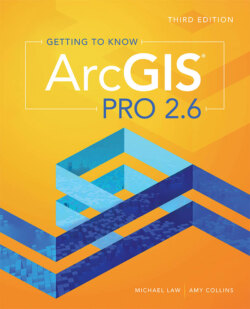Читать книгу Getting to Know ArcGIS Pro 2.6 - Michael Law - Страница 55
Create a 3D scene
ОглавлениеNow you will convert a 2D map into a 3D scene (without losing your 2D map) so that you can visualize the heights of the buildings in the map. ArcGIS Pro basemaps can be used for both 2D and 3D maps. You can turn your buildings layer into a 3D layer because it includes a roof height attribute, measured in feet.
1 In the Contents pane, right-click Buildings, and click Attribute Table. Scroll to the last column, and sort the Height attribute in descending order.What is the height of the tallest building in this layer?
2 Close the attribute table.
3 On the View tab, click the Convert down arrow, and choose To Local Scene.When the conversion is complete, a new 3D scene is added to the project. Now you will enable 3D rendering for buildings.
4 In the Contents pane, drag buildings to 3D Layers, and then release.
5 In the Contents pane, right-click the buildings layer, and click Zoom To Layer. Do not worry if the buildings do not render correctly in the 3D map—they must be extruded before they can be displayed properly. Extrusion is the process of stretching flat 2D features vertically so that they appear three-dimensional. You will extrude the buildings based on the building height attribute field.
6 With buildings selected in the Contents pane, on the Feature Layer ribbon click the Appearance tab. In the Extrusion group, click the Type down arrow, and click Base Height. For Field, choose HEIGHT, and for Unit, choose Feet.TIP You are not limited to extruding height measurements. You can create a 3D population map by extruding a population value. Any numeric value can be displayed in 3D.TIP To learn about the different extrusion types, go to the ArcGIS Pro Help topic: Maps and scenes > Layers > Layer properties > Extrude features to 3D symbology.
7 On the Appearance tab, click the Symbology tool. In the Symbology pane symbol gallery, click the current symbol, and then scroll down to the ArcGIS 3D style set and select Concrete.
8 Click the Explore tool (on the Map tab of the ribbon, or on the Quick Access Toolbar if you placed it there). Point to the Explore tool and familiarize yourself with navigation methods.You can depress the scroll wheel on the mouse to tilt and rotate a 3D scene.
9 Navigate the 3D scene. Use the mouse wheel to experiment with zooming, tilting, and rotating the scene.What if you want to present a 2D map alongside a 3D map? You will do that next.
10 At the top of the map, click the Map_3D tab and drag to place it alongside or below the 2D map.
11 Switch to the View tab, click the Link Views down arrow, and then click Center and Scale.Now when you navigate in one map, your view will adjust accordingly in the other map—the views are linked. You can go ahead and test it.
12 Save and close the project. If you are not continuing to chapter 3, it is OK to exit ArcGIS Pro.
